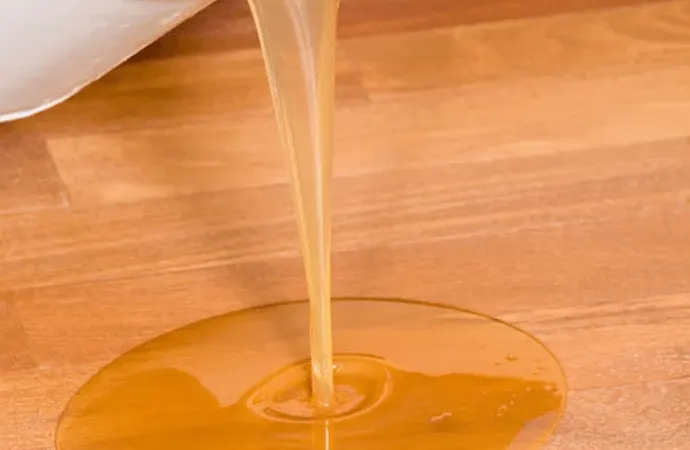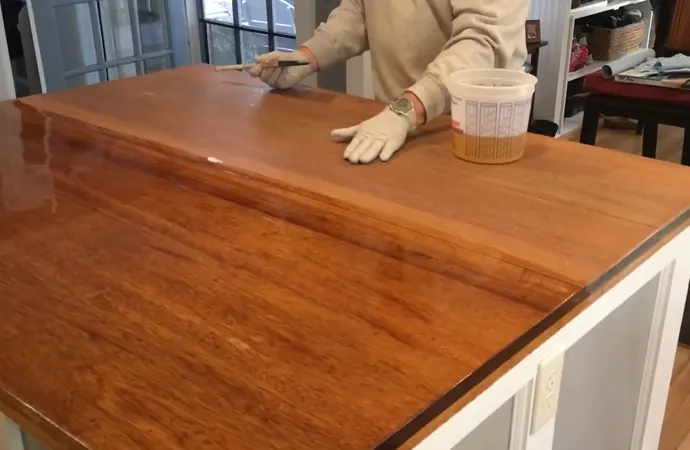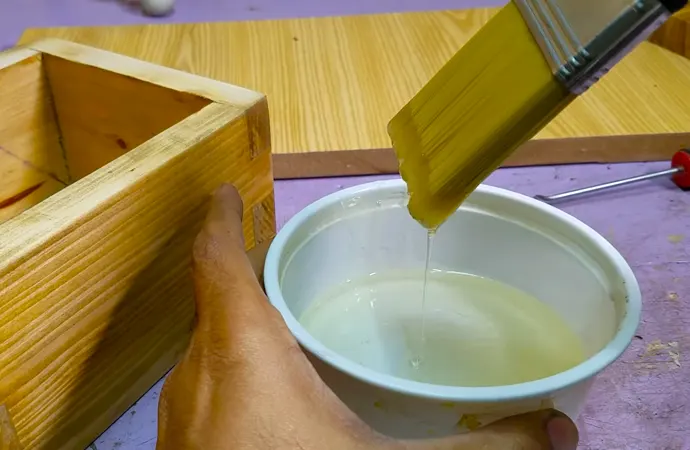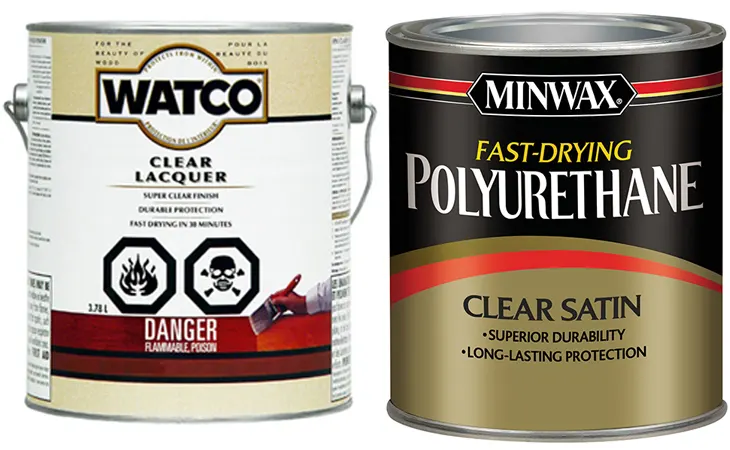Lacquer Vs Polyurethane: Top 7 Differences + FAQs
Are you wondering what Polyurethane and Lacquer are? Well, wonder no more because this article clearly unfolds and provides a blueprint on what they are, their differences, their uses, features, types, and their advantages and disadvantages of each.
To give a brief idea of what the article “Lacquer vs Polyurethane” will entail, Polyurethane and Lacquer are the most common wood furnishes used to add smoothness and a glossy coat.
These two products are often used interchangeably by individuals like me because of the confusion regarding their identities.
What Is Lacquer?
Lacquer is a wood furniture finish mostly preferred by woodworkers. This is due to the ease when applying it and its ability to dry quickly because of its thinner finish.

Furthermore, Lacquer finishes are globally known because they give maximum protection against liquids, don’t yellow with age, and require minimal maintenance.
Lacquer is often applied using a hand-rubbed cloth or a brush. It forms a film on top of the wood grain instead of saturating it. Isn’t this amazing?
What Do You Use Lacquer for?
Lacquer is used as a wood finish, nail polish, sealant on metals, and as colorant and protectant in the automotive industry.
Are There Different Types of Lacquer?
#1. Water-based Lacquer
This type of Lacquer is very different in terms of composition from the rest of the classes. This is due to the presence of fewer chemicals that are hazardous than those in other lacquers. Furthermore, water-based Lacquer is less toxic and environmentally friendly to you when applying.

However, the fantastic benefits and what makes it unique, it is more prone to tear and wear than acrylic and catalyzed lacquer.
#2. Acrylic Lacquer
It was developed in the 1950s for lighter woods such as birch, ash, and maple. All these products entailed drying to water white and synthetic acrylic polymers which ensured that the craftsmen avoided the problems that were associated with the yellowing from nitrocellulose lacquers.
Additionally, acrylic lacquers are scratch-resistant and longer-lasting than nitrocellulose lacquers. CAB-Acrylic lacquers are the most popular of these finishes.
#3. Catalyzed Lacquer
Catalyzed Lacquer contains acids or chemicals that cause the Lacquer to fully dry to a harder and long-lasting finish than evaporation alone.
These chemicals can be added at different times, such as it can be added by the manufacturer when it’s being produced, by craftsmen in their shops, or during the purchase time.
They also exit the post-catalyzed lacquers, which are called conversion varnish.
#4. Nitrocellulose lacquer
Nitrocellulose lacquer was invented in the 1920s, and since then, it has always been the most dominant finish for instruments such as violins, guitars, and pianos. It is also popular as metal coating and used in the automotive industry. It dries quickly to a high gloss, is smooth, and is more highly malleable than traditional Lacquer after curing.
Nitrocellulose lacquers carry a reddish amber with time as they age which results in a patina and beautiful lust to some woods but is not attractive to others.
Furthermore, nitrocellulose lacquer is not found on lighter woods such as ash or maple because of the yellowing that results as it ages. As it ages, it is prone to cracking and offers little protection against liquids, abrasions, and chemicals.
Pros
- Cures to a durable and rugged finish
- Protect against liquids
- It doesn’t get yellow or cloudy as it ages
- It doesn’t require additional care and has low maintenance
Cons
- It isn’t easy to apply it
- It is difficult to remove the dents or scratches
- It is toxic-gassing at first when applied
What Is Polyurethane?
Are you aware that if you take a quick look at your home, you would realize that most items in your house are made of Polyurethane? Polyurethane is the most common form of synthetic resin which is currently on the market.

Over the years, Polyurethane has proven to be the most durable one, with maximum resistance to heat for aesthetics.
What Do You Use Polyurethane for?
Polyurethane finish is a liquid generally used in flooring to provide a glossy and thick finish. It is available in either water-based form or oil-based form.
Are There Different Types of Polyurethane?
#1. Oil-based Polyurethane
Oil-based Polyurethane dries faster but is durable and has a yellow tint that increases the intensity of the color of the wood with time.

It requires few coats since it is less prone to the effects of chemicals or heat. It is toxic and imparts odor; hence should be used in a maximally ventilated room.
#2. Water-based Polyurethane
Water-based Polyurethane is very clear and remains so for a long time. It requires many coats because it is highly affected by heat and chemicals negatively. It is odorless and less toxic.
Pros
- Polyurethane finish provides the wood with a firm protective cover that protects it from being scratched.
- It provides the family heirlooms with protection and fantastic shine.
Cons
- Polyurethane is flammable; hence in liquid form
- They are at times toxic when touched or breathed in
- It takes a lot of time to harden to accept another coating
What are the Differences between Lacquer Vs Polyurethane?

1. Uses
Lacquer is better used on Formica and wood, while Polyurethane is mainly used on plastic substances.
2. Drying time
Lacquer dries faster and is thinner than Polyurethane which thicker and dries after a long period.
3. Ease in application
It is easier to apply Lacquer than Polyurethane because, with Lacquer, a low volume, high pressure is needed to spray on the target area. In contrast, Polyurethane needs a brush to apply.
4. Durability
Polyurethane is more durable than Lacquer. Polyurethane, when compared to Lacquer, is thicker and leaves a vital coating, while Lacquer is thin and durable but susceptible to discoloration and scratches.
5. Versatility
Again, polyurethane is very versatile when compared to Lacquer.
6. Toxicity/Safety
Polyurethane is toxic when touched or breathed in; hence, wearing gloves and masks while handling it while Lacquer is not harmful.
7. Yellowing
Lacquer, compared to Polyurethane, does not get cloudy or yellow as it ages, while Polyurethane gets yellow with time.
FAQs Regarding Lacquer Vs Polyurethane
Is lacquer or polyurethane better for kitchen cabinets?
I think Polyurethane is the best used in kitchen cabinets because the cabinets are subjected to a lot of tears and wear from fingerprints and closing and opening regularly.
This will help show fewer fingerprints compared to a lacquer finish; hence I highly recommend Polyurethane on kitchen cabinets.
Is lacquer or polyurethane better for outdoor furniture?
Polyurethane is the best finish to use on outdoor furniture because it provides a UV barrier and creates a durable, waterproof surface, preventing the wood’s rotting.
Will lacquer turn yellow?
Lacquer finishes are known globally because it does not turn yellow with age.
Which is harder finish, lacquer or polyurethane?
Polyurethane is more rigid than Lacquer because of its thickness which leaves a very strong coating, while Lacquer is thin and hence penetrates the wood.
Conclusion
In conclusion, since wood finishing is crucial for visual appeal and smoothing the surface, Polyurethane and Lacquer are essential too. Polyurethane is thick, durable, and dries slowly, while Lacquer is thin, less durable, and dries quickly.
